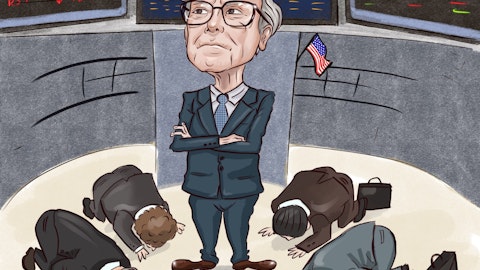In this article, we discuss the 5 stocks Stanley Druckenmiller is selling. If you want to read our detailed analysis of these stocks, go directly to the Stanley Druckenmiller is Selling These 12 Stocks.
5. Flex Ltd. (NASDAQ: FLEX)
Number of Hedge Fund Holders: 43
Percentage Decline in Stake in Q2: 39%
Flex Ltd. (NASDAQ: FLEX) is ranked fifth on our list of 12 stocks Stanley Druckenmiller is selling. The firm provides services to original equipment manufacturers and is based in Singapore. Regulatory filings show that Duquesne Capital owned more than 1.7 million shares in the firm at the end of June 2021, representing 0.87% of the portfolio. The shares are worth $30 million. The fund has slashed stake in the company by 39% compared to the end of March.
On May 7, investment advisory Citi kept a Buy rating on Flex Ltd. (NASDAQ: FLEX) stock and raised the price target to $25 from $22, underlining that the new management was demonstrating the ability to unlock value within the firm.
Out of the hedge funds being tracked by Insider Monkey, New York-based investment firm Lyrical Asset Management is a leading shareholder in Flex Ltd. (NASDAQ: FLEX) with 14.9 million shares worth more than $267 million.
4. Snowflake Inc. (NYSE: SNOW)
Number of Hedge Fund Holders: 70
Percentage Decline in Stake in Q2: 43%
Snowflake Inc. (NYSE: SNOW) is a California-based company that operates a Cloud-based data platform. It is placed fourth on our list of 12 stocks Stanley Druckenmiller is selling. According to the latest filings, Duquesne Capital owned 49,110 shares in the firm at the end of the second quarter of 2021, representing 0.34% of the portfolio. The shares are worth $11.8 million. The fund has decreased stake in the firm by 43% compared to the end of the first quarter of the year.
On August 23, investment advisory Rosenblatt kept a Buy rating on Snowflake Inc. (NYSE: SNOW) stock and raised the price target to $295 from $265, noting that the firm would likely increase fiscal 2022 guidance on the back of growth catalysts like IT spending.
At the end of the second quarter of 2021, 70 hedge funds in the database of Insider Monkey held stakes worth $12.5 billion in Snowflake Inc. (NYSE: SNOW), down from 71 in the preceding quarter worth $12.9 billion.
3. Builders FirstSource, Inc. (NYSE: BLDR)
Number of Hedge Fund Holders: 60
Percentage Decline in Stake in Q2: 57%
Builders FirstSource, Inc. (NYSE: BLDR) is a Texas-based firm that makes and sells building materials. It is ranked third on our list of 12 stocks Stanley Druckenmiller is selling. Latest data shows that Duquesne Capital owned 566,856 shares in the firm at the end of June 2021, representing 0.69% of the portfolio. These are valued at over $24 million. The fund has decreased stake in the company by 57% compared to the end of March 2021.
On August 6, investment advisory B Riley maintained a Buy rating on Builders FirstSource, Inc. (NYSE: BLDR) stock and raised the price target to $58 from $56, highlighting that builders continued to be the beneficiaries of strong housing demand.
Out of the hedge funds being tracked by Insider Monkey, Connecticut-based firm Coliseum Capital is a leading shareholder in Builders FirstSource, Inc. (NYSE: BLDR) with 8.8 million shares worth more than $377 million.
2. ON Semiconductor Corporation (NASDAQ: ON)
Number of Hedge Fund Holders: 44
Percentage Decline in Stake in Q2: 62%
ON Semiconductor Corporation (NASDAQ: ON) is placed second on our list of 12 stocks Stanley Druckenmiller is selling. The firm operates from Arizona and makes and sells semiconductors. Regulatory filings reveal that Duquesne Capital owned 706,266 shares in the firm at the end of the second quarter of 2021, worth $27 million. This represents 0.77% of the portfolio. The fund has trimmed stake in the company by 62% compared to the filings for the first quarter of the year.
On August 6, investment advisory Jefferies reiterated a Buy rating on ON Semiconductor Corporation (NASDAQ: ON) stock and raised the price target to $53 from $51, appreciating the reveal of the new 2025 operating model of the company.
At the end of the second quarter of 2021, 44 hedge funds in the database of Insider Monkey held stakes worth $1 billion in ON Semiconductor Corporation (NASDAQ: ON), up from 41 in the previous quarter worth $1.2 billion.
1. Sea Limited (NYSE: SE)
Number of Hedge Fund Holders: 104
Percentage Decline in Stake in Q2: 76%
Sea Limited (NYSE: SE) is ranked first on our list of 12 stocks Stanley Druckenmiller is selling. The company is in the entertainment and ecommerce business with headquarters in Singapore. According to the latest filings, Duquesne Capital owned 143,418 shares in the company at the end of June 2021, representing 1.13% of the portfolio. The shares are valued at more than $39 million. The fund has slashed stake in the company by 76% compared to the end of March 2021.
On August 18, investment advisory Cowen maintained an Outperform rating on Sea Limited (NYSE: SE) stock and raised the price target to $355 from $345, noting that the topline growth of the company was continuing alongside long-term investments.
At the end of the second quarter of 2021, 104 hedge funds in the database of Insider Monkey held stakes worth $12.2 billion in Sea Limited (NYSE: SE), up from 98 the preceding quarter worth $10.4 billion.
In its Q4 2020 investor letter, Hayden Capital, an asset management firm, highlighted a few stocks and Sea Limited (NYSE: SE) was one of them. Here is what the fund said:
“Sea Ltd (SE): When I wrote our Q4 2019 letter about Shopee launching a Brazilian business, it seemed very few investors or competitors knew or cared.
A year ago, I wrote: “This is the first test for the ecommerce marketplace outside of its Southeast Asia home base. Will the platform’s fun and addicting features overcome a lack of local knowledge and presence? It’s hard to predict consumer behavior and how accepting users will be to a platform – especially one that’s a foreign culture and 10,000 miles away. The only way to know is to experiment and watch the results closely.
Empirically though, it seems that what consumers find entertaining in Asia, generally translates well to Brazil (and Shopee really is as much an entertainment platform, as an ecommerce one).
For example, just look at the top 10 free apps in Brazil. Two are utility messaging apps, so we’ll ignore those (WhatsApp and
Facebook Messenger). But among the remaining eight apps, they’re all entertainment based and overwhelmingly Asian. Four are from China (Kwai, TikTok, VStatus, TikTok Lite), two from Singapore (Free Fire and Shopee, both Sea Ltd apps), and one from the US (Instagram). The commonality is that all these apps are experts at creating addictive habits, as evidenced by their personalized recommendations, avg usage time, number of logins per day per user, etc.” (LINK)
I distinctly remember having conversations with several Brazilian hedge funds as recently as last summer who were investors in Sea Ltd. When the topic of Brazil came up, many of them didn’t even know Shopee was operating in their own backyard!
Part of this stems from the fact that Shopee tends to enter markets with a bottoms-up approach. Instead of going after urban, high disposable income users first (of which these hedge fund professionals were certainly part of), they tend to initially go after those with only a few hundred or thousand USD of annual disposable income. These users tend to reside outside of major cities, have fewer choices for recreational pastime (thus turning to gaming, short-form videos, or online shopping for entertainment), can’t afford “branded” items and thus are willing to take a chance on cheaper (but still good quality) un-branded goods, and are willing to wait several weeks for it to be shipped from Asian factories.
Anyone who has studied Pinduoduo (Nasdaq: PDD) in China, will recognize this strategy and just how large of a market these consumers can be. As Shopee gains popularity in a market, they will then start to slowly move “up-market”, and cater to more urban and higher-income consumers. They’ve already followed this exact strategy in Southeast Asia, and this is the point they’ve reached in Brazil over the past year.
Shopee made its first big social push last fall, hiring over a dozen influencers with 1M+ followers to promote Shopee’s Black Friday sale (LINK). In addition, they also released their first Brazilian TV commercial last year.
It seems these initiatives are working. Shopee now consistently ranks in Brazil’s top 5 apps (while sister app Free Fire, is also the #1 grossing app). In addition, Shopee also moved Pine Kyaw (LINK), one of their key lieutenants in Vietnam who successfully helped Shopee fight off competitors (Tiki, Lazada, Sendo), to Brazil last May.
For the past year, the company has insisted publicly that the Brazil initiative is still a “test” initiated by the cross-border team. While this may have been true at first, it’s clear this is no longer a “test”, but rather a strategic focus for Shopee and posed to be the next battleground. It’s likely the company has chosen to remain tight-lipped so as to not tip off competitors, while they quietly “position the troops” to prepare for a larger assault.
For example, Shopee is also starting to allow local sellers to join the platform and list their local inventory (LINK). By definition, this is no longer a cross-border initiative (i.e. allowing their Southeast Asian sellers to sell to Brazilian consumers, and then shipping the goods directly from Asia. This is the model Aliexpress follows.).
This is the start of a localized marketplace. And similar to their early days in Southeast Asia, the goal is to reach the “tipping point” at which the marketplace becomes self-sustainable (this concept is discussed in our Q1 2019 letter; LINK). The weapons of choice in reaching critical mass: social media influencers to drive rust & awareness, free shipping & discounts to acquire / convert these new customers, and gamification of shopping to drive continued engagement, habit building, and repeat purchases.
Given all of this, and the strong (but early) traction in the local Shopee Brazil marketplace, investors need to keep an eye on this development. It is the smallest GMV contribution among Shopee’s countries currently, but a large inherent call option in the valuation. Something that so far, seems greatly underappreciated. I suspect at some point in the near future, Shopee’s management team will disclose more on the initiative, and at which point investors will be surprised by how Shopee managed to quietly build one of the largest marketplaces in Brazil.”
You can also take a peek at Warren Buffett Is Selling These 10 Stocks and 10 Best Nickel Stocks to Buy Now.





